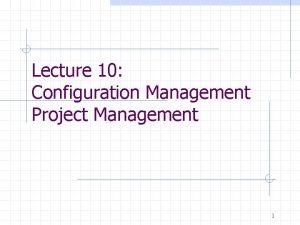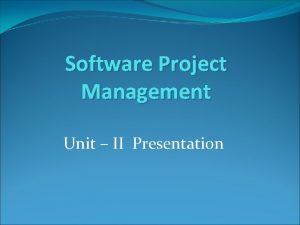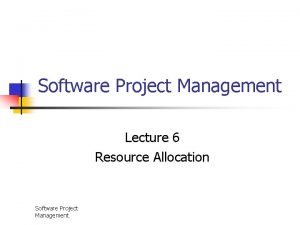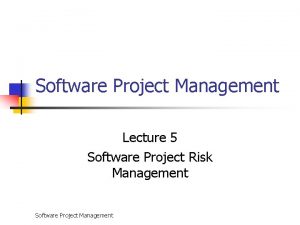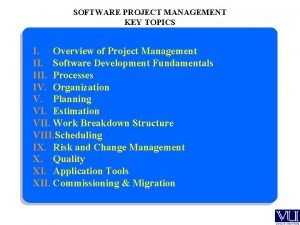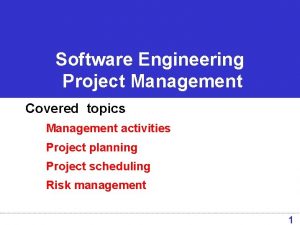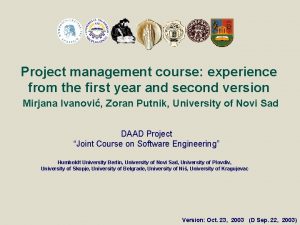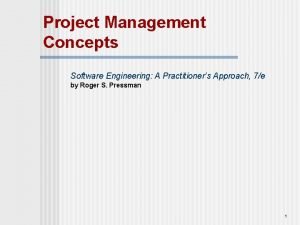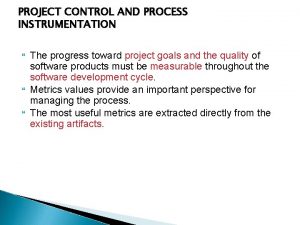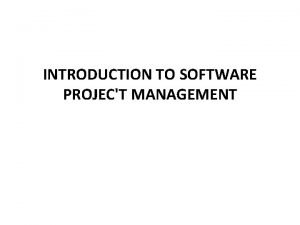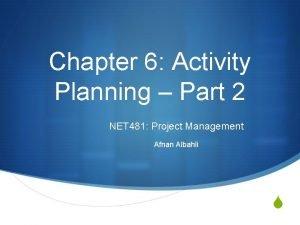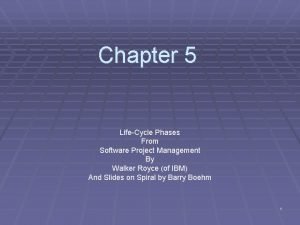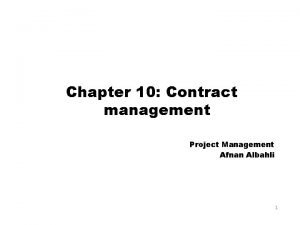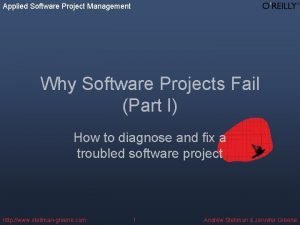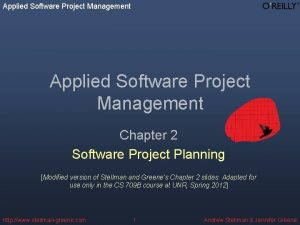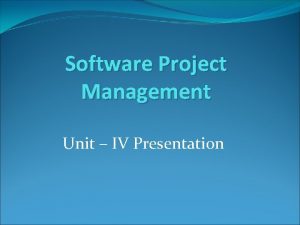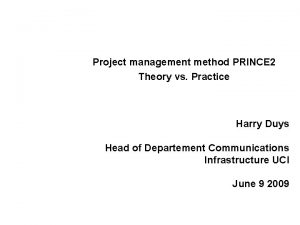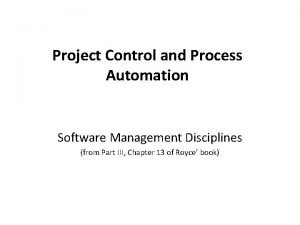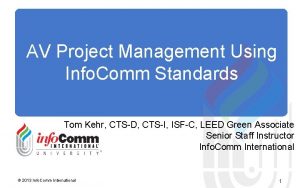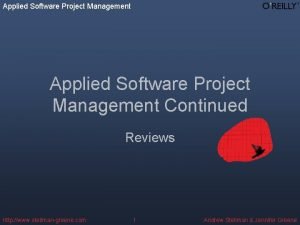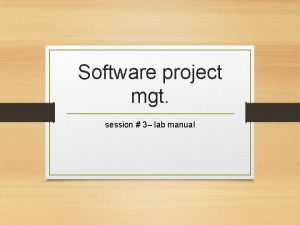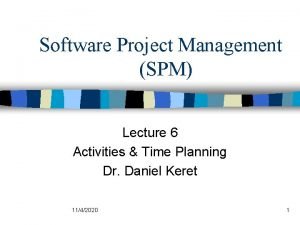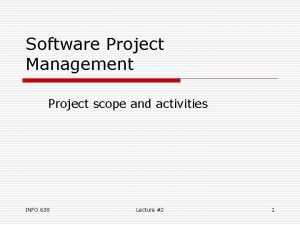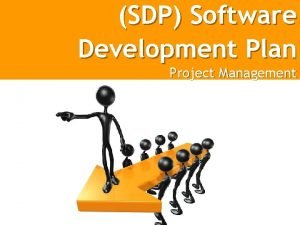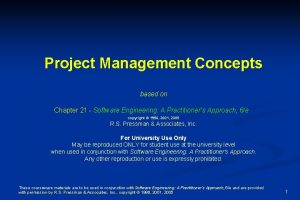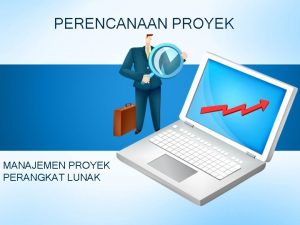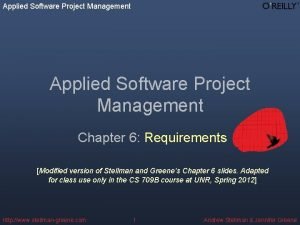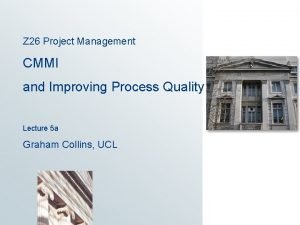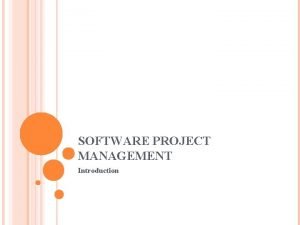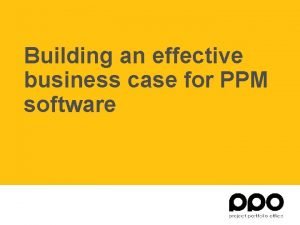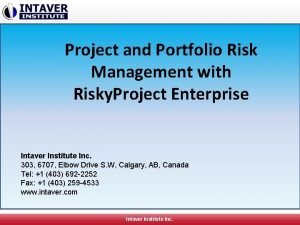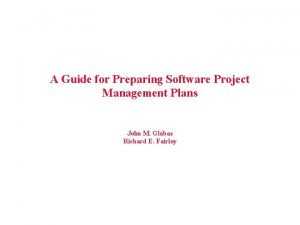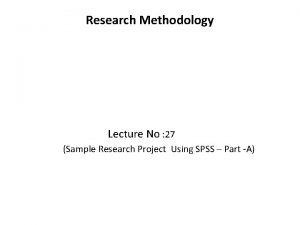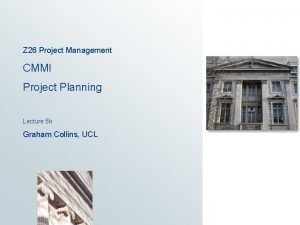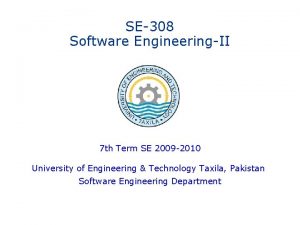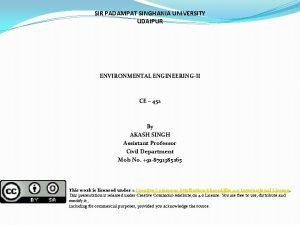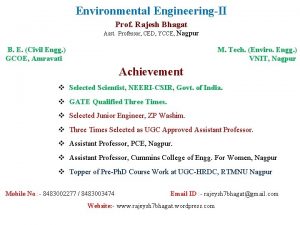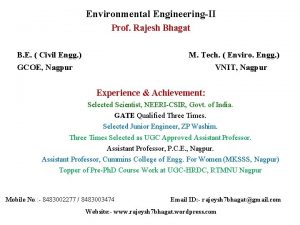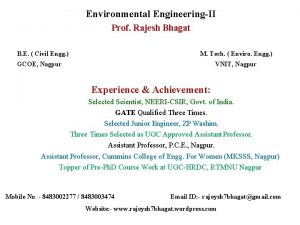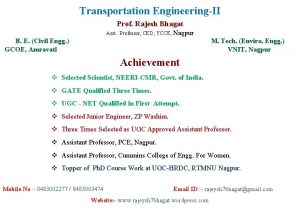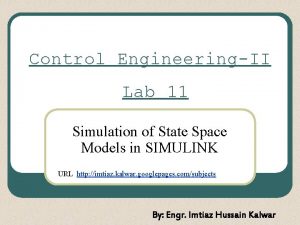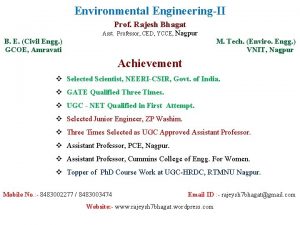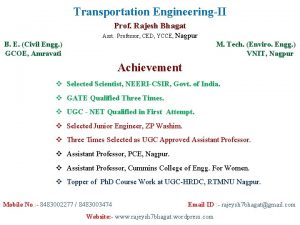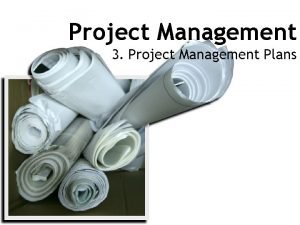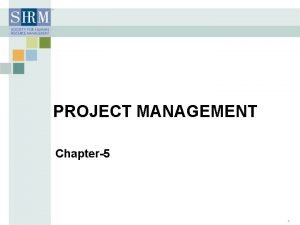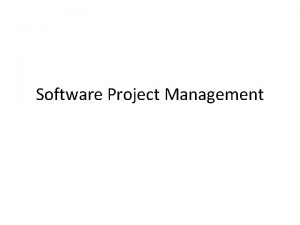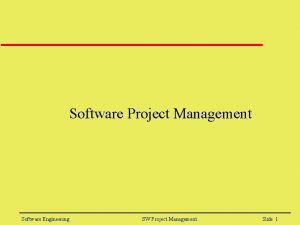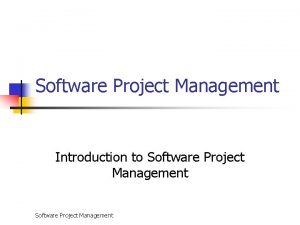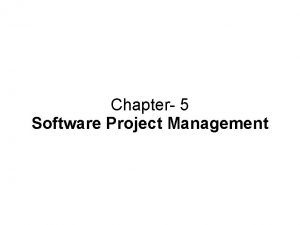Software EngineeringII Software Project Management 1 2 Software





























































- Slides: 61

Software Engineering-II Software Project Management 1

2 Software Project Management!!! IT Projects have a terrible track record A 1995 Standish Group Study found that only 16. 2% of IT projects were successful Over 31% of It projects were cancelled before completion, costing over $81 bn in the U. S. alone

3 What is Project? Project is a planned activity. Being planned it assumes that we can determine how we are going to carry out a task before we start. Develop a web page within the next four days that provides information about the departmental time table to new incoming students Definition A project is a specific(non-routine), finite task to be accomplished. It carried out in several phases and the resources available are constrained. Any activity that results in a deliverable or a product. Projects always begin with a problem. The projects is to provide the solution to this problem. When a project is finished it must be evaluated to determine whether it satisfies the objectives and goals.

4 A project is temporary endeavor undertaken to accomplish a unique purpose. Attributes of a project Unique purpose (specified product is to be created) Temporary (non-routine) Planning is required Require resources, often from various areas Carried out in several phases Involve uncertainty Project is large or complex

5 Software Projects vs. Other Types of Projects Invisibility with software progress is not immediately visible Complexity per dollar software products contain more complexity Conformity software developers have to conform to the requirements of clients. Flexibility the ease with which software can accommodate changes.

6 Definition SCOPE: what is the project trying to accomplish? what work must be done to satisfy the customer that deliverables meets the requirements. TIME: How long should it take to complete the project? what is the project’s schedule? COST: what should it cost to complete the project? The objective of any project is to complete the scope within the budget by a certain time to the customer’s satisfaction

7 What is Management? Management can be defined as all activities and tasks undertaken by one or more persons for the purpose of planning and controlling the activities of others in order to achieve objectives or complete an activity that could not be achieved by other acting independently. Management functions can be categorized as planning organizing staffing directing controlling

8 Management functions Planning predetermining a course of action for accomplishing projects objectives Organising arranging the relationship among work units for accomplishment of objectives and the granting of responsibility and authority to attain those objectives Staffing selecting and training people for completing tasks Directing creating an atmosphere that will assist and motivate people to achieve desired end result Controlling establishing, measuring, and evaluating performance of activities towards planned objectives

9 Project Management!! Project management is a system of management procedures, practices, technologies, skills, and experience that are necessary to successfully manage a project.

10 Laws of Project Management No major project is ever installed on time, within budget, with the same staff that started it. Yours will not be the first Projects progress quickly until they become 90% complete, then they remain at 90% complete forever. One advantage of fuzzy project objectives is that they let you avoid the embarrassment of estimating the corresponding costs. When things are going well, something will go wrong. When things just can’t get any worse, they will When things appears to be going better you have overlooked something

11 Continue…. If project content is allowed to change freely, the rate of change will exceed the rate of progress. No system is ever completely debugged: attempts to debug a system inevitably introduce new bugs that even harder to find A carelessly planned project will take three times longer to complete than expected, a planned project will take twice as long.

12 Project Management Advantages Responsiveness to clients and the environment Ability to make timely trade-off decisions Central focus of decisions to insure overall project optimality Better control, better customer relations, shorter development time, lower costs, higher quality and reliability, higher profit margins, sharper orientation towards results, better co-ordination, higher morale Bosses, customers, and other stakeholders do not like surprises. Good project management provides assurance and reduce risk Project management provides the tools and environment to plan, to monitor, to track, and to manage schedules, resources, cost, and quality

13 Project Management Disadvantages Greater organizational complexity More violations of company policy Lower personnel utilization More managerial conflicts

14 Management Spectrum Effective software project management focuses on the four P’s People Product Process Project

15 People Software process is populated by players who can be categorized into followings: 1. Senior Managers 2. Project Managers 3. Practitioners 4. Customers 5. End-users

16 The Project Team The Selection of team occurs early in the life cycle of a software development project. Common characteristics of effective team members technically competent Politically sensitive Strong problem orientation Strong goal orientation High self –esteem

17 The project team development Some important tools and techniques for team development Training Team Building Reward and Recognition Systems

18 Team Building A legendary sports manager once said “it’s easy to get the players. Getting them play together , that’s the hard part” Team building- developing a group of individuals to accomplish the project’s objectives- is an ongoing process. Team building helps to create an atmosphere of openness and trust. Members feel a sense of unity and a strong commitment to accomplish the project objectives

19 Five- stages in Team development Forming Storming Norming Performing Adjourning

20 level of functioning at various stages of team development

21 Project Manager Once the project is selected, the next step for the senior management is to choose a Project Manager OR When the team is formed, choose a leader It is the PM’s job to make sure that the project is properly planned, implemented and completed. It is the People - not the procedures and techniques - that are critical to accomplishing the project objectives.

22 Project Manager’s Role Facilitator (Virtual Project Manager) Many projects are international and team members may be geographically dispersed. Many projects may be carried out by different organizations at different location. Communicator PM is responsible to the project team, to senior management, to the client, to anyone else who may have a stake in the projects performance and outcome.

23 MOI model of leadership Motivation the ability to encourage technical ppl to produce to their best ability Organization the ability to mold existing processes that will enable the initial concept to be translated into a final product. Ideas the or innovation ability to encourage ppl to create and feel creative even when they must work with in bounds established for particular software product or application.

24 Project Manager’s - Responsibilities To the Organization Conservation of resources • Timely and accurate communication of project’s progress • Competent project management To the Project Team • Competent human resource management To the Client • Acceptable delivery of project’s product • Timely and accurate communication of project’s progress

25 PM’s - Responsibilities (cont. ) To the Project • acquisition of resources and personnel • dealing with obstacles arising during the course of the project • exercising the leadership needed to bring the project to a successful conclusion • trade-offs between budget, schedule, and specifications to ensure successful completion of the project

26 Project Manager’s Characteristics Technical skills § Supply of large and small technical solutions § Political sensitivity § Much of Project Management involves politics and power § Solution oriented § Goal oriented § Results rather than activity focused Openness through high self-esteem § No hiding errors, No witch hunts, No shooting the managers

27 Selecting a Project Manager The Best Project Manager is the one who can get the job done In addition the individual should have & be perceived to have by stakeholders the following qualities Credibility Sensibility Leadership Stress-Resistance

28 Credibility Technical Credibility A Reasonable understanding of the base technologies the project requires The Aim is to Interpret technical requirements of the client Converse at a useful level with project team experts To Be Able to Explain Technology to Senior Management Administrative credibility A complete understanding of project management processes Strong, consistent decision making based on mature, knowledgeable judgment

29 Sensitivity Political Sensitivity External politics • Client, Senior Management, Functional Managers • Power base must be sufficient to get what you want Internal politics • Detect and resolve conflicts between team members Technical Sensitivity Detecting when technical experts are not telling everything • Covering up their own failures • Hiding doubts

30 Leadership Def: Interpersonal influence, exercised in situations and directed through the communication process, towards the attainment of a specified goal. Leadership qualities Personal charisma Enthusiasm, Optimism, Energy, Courage, Maturity Ethical, Fair Know • When to reward, when to punish • When to delegate , when to step in • When to communicate, when to remain silent • How to capitalize on people’s strengths and cover their weaknesses

31 Stress-Resistance Causes (there are plenty of them) Constant decision making More responsibility than authority Overwork Failure to employ consistent project management processes – this is the PM’s fault Constant change Political hostility Conflict Satisfying several masters

32 Effective and Ineffective PMs

33 Project Manager vs Functional Manager Project Manager Generalist Facilitator among specialists, indirect technical support Employs holistic, systems approach Decides how resources are obtained What needs to be done and when it must be done Functional Manager Specialist in the area they manage Direct technical supervisor, applies knowledge directly Employs analytical approach Decides how something will be done and who will do it Decides what resources are required

34 Code of ethics for software engineer Software Engineers shall 1. act consistently with the public interest 2. act in a manner that is in the best interest of their client and employer 3. ensure that their products and related modifications meet the highest professional standards possible 4. maintain integrity and independence in their professional judgement 5. subscribe to and promote an ethical approach to the management of software development and maintenance 6. advance the integrity and reputation of the profession consistent with public interest 7. be fair and supportive of their colleagues 8. participate in lifelong learning regarding the practice of their profession

35 Past vs Future Management in Past Direction Manage Bossing/dictatorship Error hiding To make profit giant steps Worker supervision Future Management Empower Enable Coaching & apprising/collaboration Error admitting To hold the customer Baby steps Mentoring and profit sharing

36 Management in Past Do it yourself Play safe Crises management Planning Adhoc decision Top down Management competitive Future Management Ask for help Take risk and initiative Prevention and contingency Planned decision Top down & bottom up Collaborative and cross functioning

37 Coordination and Communication issues Kraul and Streeter examine a collection of project coordination techniques that are categorize in following manner. Formal, impersonal approaches Formal, interpersonal procedures Informal, interpersonal procedure Electronic communication Interpersonal networking

38 Product Description Composition Format Relevant standards Quality criteria

39 What to produce!!!!! A product breakdown structure (PBS)

40 Project Ten signs that indicates that information system project is in jeopardy Software people don’t understand their customer’s need The product scope is poorly defined Changes are managed poorly The chosen technology changes Business needs changes Deadline are unrealistic Users are resistant Sponsorship is lost

41 The project team lacks people with appropriate skills Managers avoid best practices and lessons learned Five-part commonsense approach to software projects: 1. Start on the right foot 2. Maintain Momentum 3. Track Progress 4. Make smart decisions 5. Conduct a postmortem analysis(*ASG)

42 The W 5 HH principle Barry Boehm suggested w 5 HH principle Why is the system being developed? What will be done, by when? Who is responsible for function? Where are they organizationally located? How will the job be done technically and managerially? How much of each resource is needed?

43 Risk Management

45 Risk Management- Definition Risk management is a process that is used extensively for various purposes Recall earlier questions raised about safety, costs, etc. z According to “Webster’s Seventh New Collegiate Dictionary”, risk is defined as a: y“possibility of loss or injury” y“the chance of loss or the perils to the subject matter of an insurance contract” and y“the degree of probability of such loss. ”(1)

48 Risk Strategies z Reactive y Software team does nothing about risks until something goes wrong y “fire fighting mode” y At best, monitors the projects for likely risks z Proactive y Begins long before technical work is initiated y Identification of potential risks (studies of probability, impact and priorities) y Objective: AVOID RISK y Responds are in a controlled and effective manner Our Concern

49 Risk Categories • Project Risks (budgetary, schedule, personnel, resource, customer) • Technical Risks (design, implementation, interfacing, verification) • Business Risks (market, strategic, management, budget) Software Risk Charette: • Known risks • Predictable • Unpredictable

50 Risk Identification Risk identification is a systematic attempt to specify threats to the project plan Identify known and predictable risks Generic specific Risk Item List Product- y Product size y Business impact y Customer characteristics y Process definition y Development environment y Technology to be built y Staff size and experience What characteristics of this product may threaten our project plan?

51 Risk Identification Product Size Risk : Estimated size of the product in LOC or FP? Percentage deviation in size of product from average for previous products? Number of users/projected changes to the requirements for the product? Amount of reused software? z Business Impact risks: y. Effect of this product on the company revenue? y. Visibility of this product to senior management? y. Amount & quality of product documentation to be produced? y. Governmental constraints on the construction of the product?

52 Risk Identification Customer related risks: (needs, personalities, contradictions , associations) Have you worked with the customer in the past? Does the customer have a solid idea of what is required? Will the customer agree to have meetings? Is the customer technically sophisticated in the product area? Does the customer understand the software process? z Technology Risks: y. Is the technology to be built new to your organization? y. Does the SW interface with new or unproven HW/SW? y. Do requirements demand creation of new components ? y. Do requirements impose excessive performance constraints?

53 Risk Identification Process Issues: y Are facilitated application specification techniques used to aid in communication between the customer and developer ? y Are specific methods used for software analysis? y Do you use specific method for data and architectural design? y Are software tools used to support the software analysis and design? y Are tools used to create software prototypes? y Are quality/productivity metrics collected for all software projects? Technical Issues: Process Risks : (4) Does senior management support a written policy statement that emphasizes a standard process for software development ? Is there a written description of the software process to be used? Is the software process used for other projects ? Is configuration management used to maintain consistency among system/software requirements, design, code and test? Is a procedure followed for tracking subcontractor performance?

54 Environment Risks: Risk Identification Is a software project/process management tool available? Development Are tools for analysis and design available? ? Are testing tools available and appropriate for the product? Are all SW tools integrated with one another? Have members of the project team received training in each of the tools? z Risk Associated with Staff Size and Experience: y. Are the best people available? y. Do the people have the right combination of skills? y. Are staff committed for entire duration of the project? y. Do staff have the right expectations about the job at hand? y. Will turnover among staff be low enough to allow continuity?

55 Risk Identification Risk Components and Drivers (U. S. Air Force guidelines) y. Performance risk: the degree of uncertainty that the product will meet its requirements and be fit for its intended use y. Cost risk: the degree of uncertainty that the project budget will be maintained y. Support risk: the degree of uncertainty that the software will be easy to correct, adapt, and enhance y. Schedule risk: the degree of uncertainty that the project schedule will be maintained

57 Risk Projection called risk estimation, attempts to rate each risk in Also two ways: y. Likelihood (probability) y. Consequences x. Develop a risk table: A risk table provides a project manager with a simple technique for risk projection x. For each identified risk, list likelihood, consequence and impact y. Risk Assessment: Examine the accuracy of the estimates that were made during risk projection. A risk referent level must be defined and the referent point or break point should be established

58 Risk Projection

59 Risk Matrix L I k e l I h o o d 5 4 3 2 1 1 2 3 4 Consequences 5

60 Risk Mitigation, Monitoring, and Management An effective strategy must consider three issues: risk avoidance, risk monitoring, and risk management and contingency planning. z A proactive approach to risk avoidance is the best strategy. Develop a plan for risk mitigation. For example: assume that high staff turnover is noted as a project risk r 1, some of the possible steps to be taken are these: ymeet with current staff to determine causes for turnover yassume turnover will occur and develop techniques to ensure continuity when people leave. ydefine a backup staff member for every critical technologies.

61 Risk Mitigation, Monitoring, and Management As the project proceeds, the following factors can be monitored: general attitude of team members based on project pressures, the degree to which the team has jelled, interpersonal relationship among team members, availability of jobs within the company and outside it z In addition of these factors, the project manager should monitor the effectiveness of risk mitigation steps. z Risk management and contingency planning assumes that mitigation efforts have failed and that the risk has become reality.

62 Safety Risks and Hazards Software safety and hazard analysis are software quality assurance activities that focus on the identification and assessment of potential hazard that may impact software negatively and cause an entire system to fail. z If hazards can be identified early in the software engineering process, software design features can be specified that will either eliminate or control potential hazards.

66 SEI Software Development Risk

67 Summary z Risk analysis is an important part of most software projects. z Risk analysis requires a significant amount of project planning effort. z Understanding risk helps you know where to commit your resources. z If you don’t actively attack the risks, they will actively attack you. z Major projects should all have a risk management plan. .

68 Questions
 Importance of software project management
Importance of software project management Iteration workflows in software project management
Iteration workflows in software project management What is strategic assessment in software project management
What is strategic assessment in software project management Configuration item definition
Configuration item definition Improving software economics in software project management
Improving software economics in software project management The role of project management in achieving project success
The role of project management in achieving project success Reducing project duration
Reducing project duration Modern project management began with what project
Modern project management began with what project When conducting post project audits
When conducting post project audits Ms project agile template
Ms project agile template Types of terminations
Types of terminations Integrating metrics within the software process
Integrating metrics within the software process Managing assets vs asset management
Managing assets vs asset management Configuration management in project management
Configuration management in project management Principles of project cost management
Principles of project cost management Integration management in project management
Integration management in project management Four p's in software engineering
Four p's in software engineering Strategic assessment in software project management
Strategic assessment in software project management Resource requirements example
Resource requirements example Software project risk
Software project risk Software project management topics
Software project management topics Risk management activities in software engineering
Risk management activities in software engineering Project management for software development
Project management for software development Project management tools in software engineering
Project management tools in software engineering 4 p's of project management in software engineering
4 p's of project management in software engineering Mtbf and maturity
Mtbf and maturity Function point in software project management
Function point in software project management Introduction to software project management
Introduction to software project management Pragmatic artifacts in software project management
Pragmatic artifacts in software project management Activity based approach in software project management
Activity based approach in software project management Odw 5e ch05 arrange the software development life cycle
Odw 5e ch05 arrange the software development life cycle Stages in contract placement in software project management
Stages in contract placement in software project management Applied software project management
Applied software project management Applied software project management
Applied software project management Ic poma garlasco
Ic poma garlasco Prioritizing monitoring in software project management
Prioritizing monitoring in software project management Step wise project planning
Step wise project planning Prince software project management
Prince software project management Seven core metrics in software project management
Seven core metrics in software project management Av project management software
Av project management software Applied software project management
Applied software project management Software project management lab manual
Software project management lab manual Activities of spm
Activities of spm Activities covered by software project management
Activities covered by software project management Sdp software development plan
Sdp software development plan 4 p's of project management in software engineering
4 p's of project management in software engineering Wbs software project management
Wbs software project management Objectives of gym management system
Objectives of gym management system Aon to aoa
Aon to aoa Applied software project management
Applied software project management Cmm levels in software project management
Cmm levels in software project management Software project management course
Software project management course Ppm tool business case
Ppm tool business case Project portfolio risk assessment
Project portfolio risk assessment Project management software
Project management software Plan managerial model
Plan managerial model Top management and middle management
Top management and middle management Top management middle management first line management
Top management middle management first line management Top management middle management first line management
Top management middle management first line management What is project background
What is project background Methodology of project sample
Methodology of project sample Cmmi project management
Cmmi project management













